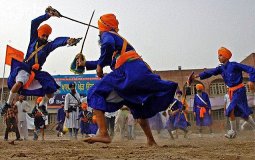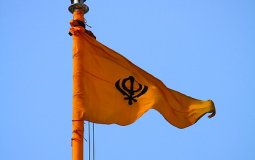Long hair helps Sikhs feel a connection to their Gurus. It's a physical similarity they share, reminding them to embody the qualities their Gurus represented.
In the British Museum, there is a Sikh fortress turban, a rare object of which only five exist in Britain. This particular one is wrapped around a wooden cone and was made for a ceremonial purpose rather than everyday wear.
When a Kaur discovers or shapes herself, she finds connection within a community. This process helps her develop as a unique individual with her own physical appearance, personality, and beliefs.
In contemporary Sikh circles, the term Gatka is commonly used to encompass all aspects of Sikh martial arts. However, historical sources generally refer to the art as Shastravidiā, or the 'Science of Weapons.'
Sikhism has a unique idea of God. They call God "Ik Onkar," which means "one constant." In Sikhism, God has no gender and is beyond time and space. They also believe God has no physical form.
Sikhs have been living in the United States for 125 years, and today their population stands at around 700,000. Amarjit Singh, a Sikh based in the U.S. and former President of the Gurdwara Sahib Stockton committee, emphasizes the importance of Gurdwaras to the Sikh community.
The Nishan Sahib represents Sikhs in body, mind, and action. It declares their physical, mental, and spiritual independence, emphasizing unity under its protection.
“Inhale Sat, Exhale Naam" guides us in preparing to shed our physical form fearlessly.
The gurdwara's significance extends beyond its spiritual role, as it welcomes a large influx of tourists and devotees every day.









